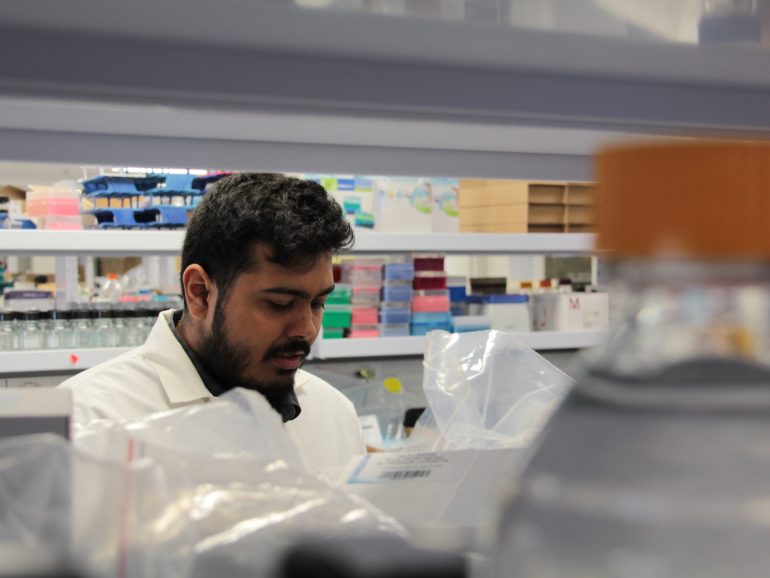The question is no longer if cannabis contains chemical compounds that can be used therapeutically, but how these compounds can be extracted or produced on an industrial scale, and how many different diseases it can treat. As this new field opens wider with the highly-anticipated changes in marijuana legislation in Canada and elsewhere in the world, there are some companies who have abandoned the plant for the source material.
BetaKit spoke with Kevin Chen, CEO and co-founder of Hyasynth Bio, a Montreal-based startup that genetically engineers yeast to create a range of cannabinoids for therapeutic purposes.
Can you explain exactly what it is that Hyasynth Bio does?
We make cannabinoids. Cannabinoids are the active compounds from cannabis, more broadly defined as compounds that affect the endocannabinoid system. [This system] is what connects you smoking weed to you getting hungry, among other things. If you think about how smoking makes you feel happy, for instance, that becomes really interesting in terms of treatment for depression. There are a lot of things that are connected with this system, but not much has been targeted and defined as a therapeutic.

But you’re not actually working with marijuana plants. Can you explain what it is that you actually do to produce those cannabinoids?
We don’t do anything with plants at all whatsoever, which is probably one of the interesting things about this technology. The DNA we work with comes from the DNA sequence; this is information that’s available online. We treat DNA like it’s information and use that information to give yeast instructions to produce cannabinoids. Then the yeast can be grown at a thousand or a million litres in scale, and produce a global supply of any cannabinoid that we know about and also ones that we don’t know about yet.
How do you see your company changing the current use of medical marijuana?
We’re looking at an industry that’s in early stages but is developing quickly, so we don’t yet know what the benefits could be or will be. We’re entering it as a supply-chain so instead of people buying acres and acres of land and spending a lot of money on grow lighting or worrying about crop yield and waiting three or four months to grow plants, we have a process that would take about ten times less space to produce a lot more, and then instead of three months to grow a plant, it takes a week to grow a culture.
Our team sees DNA as an inspiration for technology where we can take it, rewrite it and add other parts in, and optimize different aspects of the yeast genome so that it grows quickly and makes the parts that we want it to. Since yeast has an industrial fermentation process that’s been around for a century or more, it makes it very amenable to large-scale industrial production.
Is there more openness to what you’re doing because you’re taking the illegality out of it?
We’re looking at an industry that’s in early stages but is developing quickly, so we don’t yet know what the benefits could be or will be. – Kevin Chen, CEO and co-founder of Hyasynth Bio
There are still a few questions for us to address when it comes to how we are legislated and also how the plants are legislated. We are definitely not in a grey area at all. We keep up to date with all the regulators in Canada. In the US, we’re less active but it’s a very different situation — it’s a lot more grey, as it is in Europe. We’re taking the approach of being proactive and making sure that Health Canada knows what we’re doing. Their response has been very positive and it’s been great so far working with them. If you consider this as a medicine, then we want to have better medicine for everyone.
Are you focused entirely on therapeutic versus recreational?
The solution we’re developing can do a lot more than the actual plant would be capable of. We’re looking at creating custom products that work to target specific conditions and we’re more interested in heading in that direction than making any recreational use product.
Can you manipulate the DNA to have certain characteristics?
We can make anything that people would need or want to have in the end product. That might involve us engineering a specific strain of yeast that’s going to produce that end product. Or there’s different ways of manufacturing pure THC… basically we can make any formation that someone is looking for to make medicine.
Is part of your goal to make these products more easily accessible and less expensive?
It’s a pretty cost-effective process. It compares in that it’s ten times cheaper than growing plants. It also depends on which compounds you’re looking for. There are some valuable compounds that are found in the plants in very small quantities. You’d need about a thousand tons of plants to get a relevant amount of the compound out, but it has a lot of potential for medicine. Those are compounds that we can target specifically and use a yeast process to make the compound, and that would be the only process that actually exists to make these in large quantities.
So what are your long term goals?
Using yeast to manufacture products is becoming more popular as a concept. So there are a lot of other products that are natural and aren’t necessarily controlled substances. Scorpion venom is one, or we were chatting as a joke about the specific compound in bullet ants that causes massive amounts of pain. That could be tweaked and turned into a pain treatment, potentially. These are the kinds of biological products that interest us, and we’ll always be in that area — using biotechnology to solve problems and make interesting things. For now, the cannabinoids have a lot of potential and we’re going to keep exploring that.


